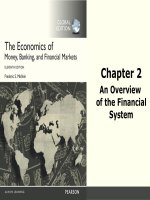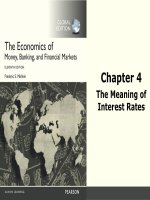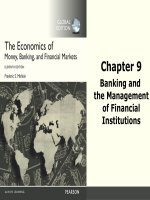The economics of money, banking, and financial institutions 2nd ch17
Bạn đang xem bản rút gọn của tài liệu. Xem và tải ngay bản đầy đủ của tài liệu tại đây (742.1 KB, 34 trang )
Chapter 17
Tools of Monetary
Policy
© 2005 Pearson Education Canada Inc.
Overview
So far we derived a multiplicative relation between M and MB
M = m × MB
and discussed three monetary policy tools that the Bank of Canada
can use to manipulate i and M. These tools are
•
open market operations
•
Bank of Canada advances, and
•
government deposit shifting
In recent years, however, the Bank conducts policy by setting an
operating band for the overnight interest rate ior and targeting ior
at the midpoint of the band. In doing so, the Bank permits M to
do whatever necessary to keep ior on target.
© 2005 Pearson Education
17-2
The Role of Money
Before we go on, we have to clear up a potential confusion:
Although the Bank of Canada can control both i and M, it
would be wrong to view i and M as distinct policy
instruments. The reason is that a given i policy has to be
supported by a given M policy. That is , the Bank
influences i by adjusting M. To put it differently, i is the
price of M and the Bank affects the price of M (that is,
the interest rate) by controlling the quantity of money.
With this in mind, let’s discuss the institutional framework
within which the Bank conducts monetary policy.
© 2005 Pearson Education
17-3
The Large Value Transfer System, LVTS
•
•
•
The LVTS (introduced on February 4, 1999) is an
electronic, real-time net settlement network, designed to
provide immediate finality and settlement to timecritical transactions
LVTS participants know in real time their large-value,
wholesale transactions (over $50,000). Although these
transactions account for less than 1% of the total
number of transactions, they account for about 94% of
the value of transactions in Canada
The LVTS uses multilateral netting — only the net
credit or debit position of each participant vis-à-vis all
other participants is calculated for settlement
© 2005 Pearson Education
17-4
LVTS Participants
As of November 2002, in addition to the Bank of Canada, there
were 13 LVTS participants --- members of the CPA who
participate in the LVTS and maintain a settlement account at
the Bank of Canada. These are:
Big Six,
Alberta Treasury Branches,
Bank of America Canada,
Banque Nationale de Paris Canada,
La Caisse centrale Desjardins du Québec,
Credit Union Central of Canada,
HSBC Bank Canada, and the
Laurentian Bank of Canada.
© 2005 Pearson Education
17-5
Systemic Risk
The LVTS has been put in place to eliminate systemic
risk. In fact, participants can make a payment only if
• they have positive settlement balances in their accounts
with the Bank of Canada,
• posted collateral (such as T-bills and bonds), or
• explicit lines of credit with other LVTS participants
© 2005 Pearson Education
17-6
Real-Time Settlement Systems in Other
Countries
The LVTS has been put in place in order to eliminate systemic risk
— the risk to the entire payments system due to the inability of one
bank to fulfill its payment obligations in a timely fashion. Of,
course it is not just Canada that is concerned about systemic risk.
Country
Year introduced
U.S. (Fedwire) 1918
Sweden 1986
Germany and Switzerland
1987
Japan 1988
Italy
1989
Belgiumand U.K.
1996
France, Hong Kong, and NL
1997
© 2005 Pearson Education
17-7
Non-LVTS Transactions
•
•
•
These are non-LVTS (paper-based) payment items,
such as cheques
These items are cleared through the Automated
Clearing Settlement System (ACSS), an electronic
payments system also operated by the CPA
The ACSS aggregates interbank payments and
calculates the net amounts to be transferred from and
to each participant's settlement account with the
Bank of Canada
© 2005 Pearson Education
17-8
Direct and Indirect Clearers
Direct Clearers:
•
The subset of LVTS participants who participate directly in the
ACSS and are known as direct clearers
Indirect Clearers:
•
These are the deposit-taking financial institutions that are
members of the CPA but do not have a clearing account with the
Bank of Canada.
•
Indirect clearers hold deposits in direct clearers in exchange for
a variety of services, including cheque clearing, foreign exchange
transactions, and help with securities purchases
© 2005 Pearson Education
17-9
The Operating Band of 50 Basis Points for
the Overnight Interest Rate
The upper limit defines
the bank rate — the rate
the Bank charges LVTS
participants that require
an overdraft loan to
cover negative settlement
balances
The lower limit is the rate
the Bank pays to LVTS
participants with positive
settlement balances
© 2005 Pearson Education
17-10
The Bank’s Standing Liquidity Facilities
At the end of each day, each LVTS participant must bring
its settlement balance with the Bank close to zero. The
Bank therefore stands ready (we call this standing
liquidity facilities) to provide or absorb liquidity with an
overnight duration to participants facing unforeseen
liquidity shocks.
The initiative is on the side of the LVTS participant. A
participant may use the Bank’s lending facility to obtain
(against eligible collateral) overnight liquidity in case of a
shortage, or it may use the deposit facility to make
deposits in case of excess liquidity.
© 2005 Pearson Education
17-11
Pre-settlement Trading
Participants can reduce the costs of either positive or
negative positions by trading with each other in the
LVTS pre-settlement period at the end of the day (6:006:30 p.m.).
In fact, the typical bid-ask spread on overnight funds in
the interbank market has been less than 1/8%, much
less than the 50 basis points on LVTS.
Hence, participants can adjust positions with each
other in the overnight market at a better return than
can be achieved at the Bank’s standing facilities.
© 2005 Pearson Education
17-12
The Market Timetable
© 2005 Pearson Education
17-13
The Bank’s Implementation of the
Operating Band for ior
If ior ↑ towards the
upper limit, then the
Bank will lend at ib to
put a ceiling on ior
If ior ↓ towards the lower
limit, then the Bank will
accept deposits at ib less
50 basis points, to put a
floor on ior
© 2005 Pearson Education
17-14
Supply and Demand for Settlement
Balances and Overnight Interest Rate, ior
The equilibrium ior is
indeterminate and
could be anywhere
within the 50-basispoint band.
This means that the
actual ior will be
somewhat different
from the target ior
indicated at the start
of the banking day
by the Bank.
© 2005 Pearson Education
17-15
The Bank’s Current Approach to Monetary
Policy
In February 1991, the Bank’s
governor and the minister of
finance announced a series of
declining π targets. The
targets were 3% by the end of
1992, falling to 2% by the end
of 1995, to remain within a
range of 1%-3% thereafter.
The 1%-3% target range for π
was renewed in December
1995, in early 1998, and again
in May 2001, to apply until the
end of 2006.
The goal of the Bank’s current
policy is to keep π at the
midpoint of the π target range,
2%.
© 2005 Pearson Education
17-16
How the Bank Keeps π From
Falling Below the Target Range
The Bank expects
the economy to
slow down and
wishes to ease
monetary
conditions.
It lowers the
operating band for
ior, thereby
encouraging banks
to borrow R either
from each other at
ior or from the
Bank at ib
© 2005 Pearson Education
E =
euro
$
The ↓ in i and E lead to an ↑ in
M, AD, and P, thereby
preventing π from falling
below the target range.
17-17
How the Bank Keeps π From
Moving Above the Target Range
E=
The Bank expects
the economy to be
exceeding its
capacity in the
future and wishes
to slow it down.
euro
$
The ↑ in i and E lead to an ↓ in M, AD,
and P, thereby preventing π from
moving above the target range.
It raises the
operating band for
ior in order to
prevent
inflationary
pressures from
building.
© 2005 Pearson Education
17-18
The Bank’s Influence on Long-Term
Interest Rates
By changing the operating band for ior the Bank sends a signal
regarding the direction that it would like i and M to take.
•A rise in the band and thus ib is a signal that the Bank would like to
see ↑ i and ↓ M in the economy.
•A fall in the band is a signal that the Bank would like ↓ i and ↑ M.
However, the Bank’s direct influence on long-term rates diminishes as the
time period ↑. Long-term rates can be either higher or lower than short-term
rates depending on expectations about π and the level of short-term rates in
the future, the relative balance between the demand for and supply of
loanable funds, the level of i in the U. S., and the relative stance of monetary
policies in the two countries.
© 2005 Pearson Education
17-19
Open Market Operations
Two Types
1. Dynamic:
Meant to change MB
2. Defensive:
Meant to offset other factors affecting MB
Advantages of Open Market Operations
1.
2.
3.
4.
Bank has complete control
Flexible and precise
Easily reversed
Implemented quickly
© 2005 Pearson Education
17-20
SPRAs and SRAs
Over the years, the Bank introduced additional tools in its conduct of
monetary policy.
1.
2.
In 1985, the Bank introduced repos, which in Canada are known
as Special Purchase and Resale Agreements (SPRAs)
In 1986, the Bank introduced reverse repos, known in Canada
as Sale and Repurchase Agreements (SRAs)
By 1994, the Bank stopped conducting open market operations in
government of Canada T-bills and bonds and its most common
operations since then have been repurchase transactions, either
SPRAs of SRAs. SPRAs and SRAs, are conducted with primary
dealers (formerly known as jobbers) --- the Big
Six and the major investment dealers.
© 2005 Pearson Education
17-21
The Bank’s Use of SPRAs to Reinforce
the Target ior
If overnight funds are traded at a rate higher than the target ior, the
Bank enters into SPRAs at a price that works out to the target ior.
Bank of Canada
Assets Liabilities
SPRAs +100 Settlement Balances +100
Direct Clearers
Assets Liabilities
Settlement Balances +100
SPRAs +100
Hence, SPRAs relieve undesired upward pressure on ior
© 2005 Pearson Education
17-22
The Bank’s Use of SRAs to
Reinforce the Target ior
If overnight funds are traded at a rate below the target rate, the Bank
enters into SRAs, at a price that works out to the target ior
Bank of Canada
Assets Liabilities
Settlement Balances - 100
SRAs
+100
Direct Clearers
Assets Liabilities
Settlement Balances -100
SRAs
+100
Hence, SRAs alleviate undesired downward pressure on ior
© 2005 Pearson Education
17-23
Bank of Canada Lending (Advances)
Two Types
1. Standing Liquidity Facility, to reinforce the operating band for ior
2. Last Resort Lending
Lender of Last Resort Function
1. To prevent banking panics
CDIC fund not big enough
Examples: Canadian Commercial Bank and Northland Bank
2. To prevent nonbank financial panics
Examples: 1987 ‘Black Monday’ stock market crash
Announcement Effect
1. Problem: False signals
© 2005 Pearson Education
17-24
Bank of Canada Advances to
Members of the CPA
© 2005 Pearson Education
17-25









